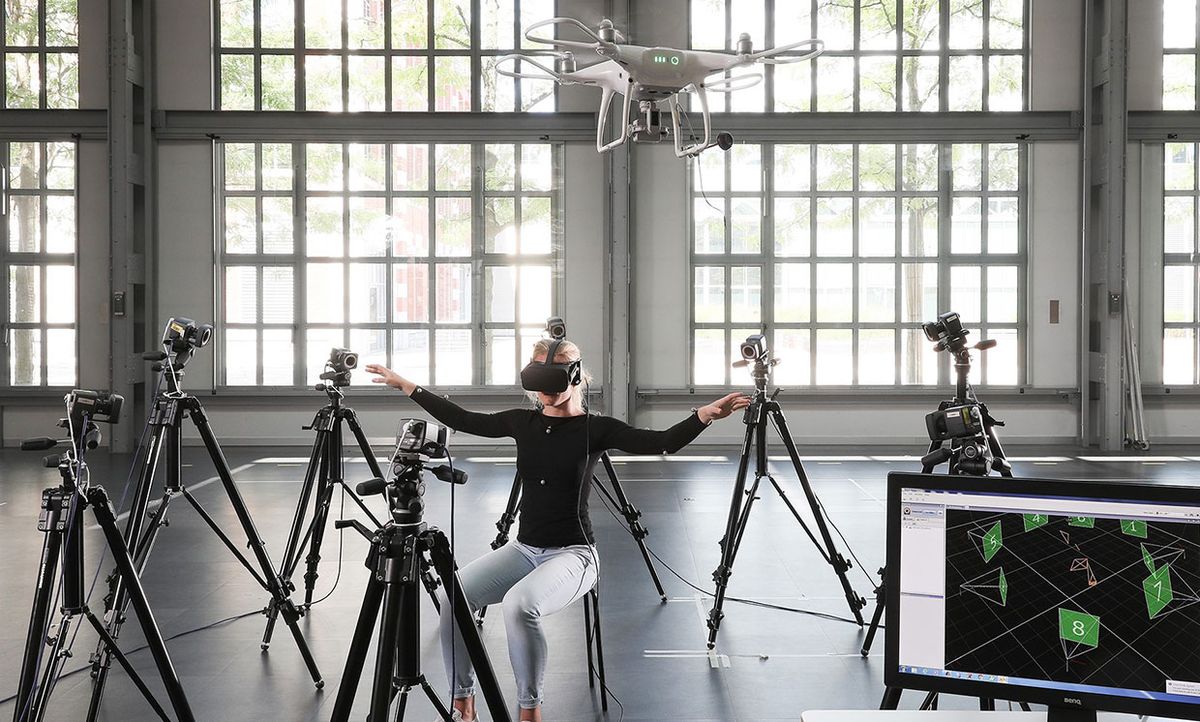Using only the movements of one’s torso to pilot a drone is more intuitive—and more precise—than a joystick, according to new research from engineers at the École Polytechnique Fédérale de Lausanne (EPFL) in Switzerland.
The technique, tested in virtual reality and with real drones, requires less mental focus from the pilot and frees up their head and limbs. So, for instance, a drone operator at a natural disaster site or on a search and rescue mission could concentrate on looking around and analyzing visual information rather than controlling the flight path of the drone.
The team also found that torso control is easier to learn and more intuitive than a traditional joystick for most people.
“It’s not that a joystick does not work—pilots for drone racing do amazing things with their joysticks—but we’ve noticed that for some people, it can be difficult to learn and you have to be really focused while you’re doing it,” says study author Jenifer Miehlbradt, a graduate student at EPFL.
In a series of experiments described this week in the journal PNAS, a team led by Miehlbradt and EPFL neuroengineer Silvestro Micera set out to come up with an alternative, easier way to pilot a drone.

First, they stuck over a dozen infrared markers all over the upper body of 17 volunteers and asked them to follow a virtual drone through a simulated landscape in virtual reality. “We asked them to follow the movements of the drone with their body in a way that felt natural to them,” says Miehlbradt.
One participant opted to fly the drone like Superman—with one arm extended above his head—and another chose to “swim” through the air, but everyone else used either their torso alone or their torso and arms to glide like a bird.
Next, in a first-person virtual reality simulation, 39 volunteers were asked to follow a path of clouds as closely as possible. Across the board, torso control was easier to learn and more precise than torso and arms or joystick control.
Plus, it actually feels like flying, says Miehlbradt.
Finally, it was time to try out the torso technique with real drones. Participants were allowed to train for nine minutes in virtual reality, then were given control of a quadcopter with FPV video feedback and allowed to freely fly for two minutes to get used to its dynamics.
“At first, it’s a bit scary,” says Miehlbradt. “It takes a minute to get used to this feeling of ‘I’m over there, with this object that is moving.’ It’s extremely immersive.”
In their final test, volunteers were asked to steer the drone through six gates arranged along a figure-eight trajectory. With the aforementioned minimal training, they did well, steering the quadcopter through the gates without collisions 88 percent of the time.
These initial experiments were done with reflective markers on the body and a motion-capture system involving cameras set up around the subject. While a tried-and-true method for motion analysis, such a system is too bulky and expensive for widespread, commercial use.
Now, a second team at EPFL has built the “FlyJacket”—a soft jacket with a motion-sensing device on the back, an arm-support system to prevent fatigue, and VR goggles for simulation. This portable system could eventually be applicable to consumer drones or other types of robots.
In the future, the team’s screening method could also be used to identify common, intuitive control patterns for robots of various shapes, says Miehlbradt. Maybe even a flying robot that can transform its shape in mid-air?
And, yes, we know you’re thinking it: This type of body control could—and very likely will—be applied to virtual reality and other types of gaming. During development, the team often set up demonstrations on campus to let people try out flying the drones. The response was unequivocal: “They love it,” says Miehlbradt with a laugh. “It’s something new. It really gives you a feeling of flying…I think it could become more popular than a joystick.”
Megan is an award-winning freelance journalist based in Boston, Massachusetts, specializing in the life sciences and biotechnology. She was previously a health columnist for the Boston Globe and has contributed to Newsweek, Scientific American, and Nature, among others. She is the co-author of a college biology textbook, “Biology Now,” published by W.W. Norton. Megan received an M.S. from the Graduate Program in Science Writing at the Massachusetts Institute of Technology, a B.A. at Boston College, and worked as an educator at the Museum of Science, Boston.



